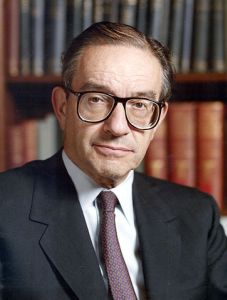
Alan Greenspan in greener days
December 5, 1996, then-Fed-Chair Alan Greenspan warned us about the “irrational exuberance” he felt was creeping into the market (the “Tech Bubble”).
“Clearly, sustained low inflation implies less uncertainty about the future, and lower risk premiums imply higher prices of stocks and other earning assets. We can see that in the inverse relationship exhibited by price/earnings ratios and the rate of inflation in the past. But how do we know when irrational exuberance has unduly escalated asset values, which then become subject to unexpected and prolonged contractions as they have in Japan over the past decade?”
The S&P opened December 1988 at 276.50. The index had tripled since the beginning of 1988 and was up almost 6 times since the beginning of 1982 (a prime example of a secular bull market at work). Greenspan was right about irrational exuberance working its way into the market. It was. He was just a few years early. The S&P had another double left in it, peaking at 1550 in March of 2000. Fortunately for him, as was usually the case, his comment was very circumspect/obtuse. As we have pointed out in the past, something Greenspan was well aware of, market prognostication (for that matter any economic prognostication) is very difficult.
“It’s deja vu all over again.” —Lawrence Peter Berra

Yogi Berra
Cautionary words, such as those offered by Mr. Greenspan, are coming at us all the the time. Thank you Yogi for this apt description of the phenomenon. In the case of the stock market the phenomenon decribed is people trying to call a top. Though Greenspan’s “irrational exuberance” is more nuanced than the average pundit, it telegraphed the same message to people knowledgeable about the market … red light, time to be cautious. Last week in the Fed minutes we received a similar message (Deja vu):









Leave A Comment